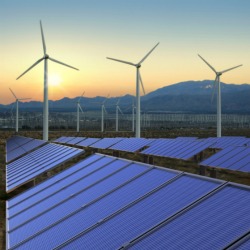 Big-name companies are increasingly embracing wind power and other sources of renewable energy. Ranked among green investors such as Google and Walmart, home furnishings retailer IKEA is on track to spend about $2 billion on its own wind and solar programs up to 2015. In addition, the company recently announced plans to buy its first North American wind energy project, currently under construction in Alberta.
Big-name companies are increasingly embracing wind power and other sources of renewable energy. Ranked among green investors such as Google and Walmart, home furnishings retailer IKEA is on track to spend about $2 billion on its own wind and solar programs up to 2015. In addition, the company recently announced plans to buy its first North American wind energy project, currently under construction in Alberta.
Brendan Seale, sustainability manager of IKEA Canada, speaks with NAW about IKEA's global renewable energy progress and ambitions.
According to Seale, the IKEA Group is aiming to become energy independent by 2020 by offsetting all of the electricity it consumes worldwide with company-owned renewable energy. Considering IKEA has stores in more than 25 countries, that means a whole lot of power. The company has a midterm goal to reach 70% renewables by 2017, and IKEA is about a third of the way there.
Sure, going green helps a company improve its public image, but Seale maintains there are other, more important motivations at play. IKEA considers three main benefits: sustainability, cost savings and the availability to continue to improve its core business.
"We really see it as a win-win-win," he explains. "Obviously, there's a clear sustainability benefit to increasing the availability of renewable energy around the world. IKEA wants to contribute and take a lead in doing that. But it also enables us to control our costs and manage our cost profile in a really smart way as we move forward.
"Going from a net consumer of energy to a net producer, you could imagine the impact that could have long term on our books," Seale continues. "It allows us to continue to invest in our business and really translate that into benefits to our customers, which is providing home furnishing solutions that are high quality at low prices. That's really what's driving it."
IKEA is employing several cleantech solutions – including biomass, energy efficiency, and even electric-vehicle chargers – but Seale says the company is looking to make investments primarily in solar and wind power.
To date, IKEA has either installed or committed to install a total of about 765,000 solar panels on its buildings worldwide. Altogether, the panels are expected to produce approximately 120 GWh annually. Because IKEA has rooftops on which to build it, solar makes a lot of sense. So, the bigger question is, why bother with wind power?
"Wind projects generate a lot of energy, comparatively speaking," Seale notes.
"We look at opportunities on a case-by-case basis," he adds. "In some markets, wind is a prudent investment to make. In other markets, solar is a more prudent investment to make. And in some markets, both are prudent." Nonetheless, he says the two resources are highly beneficial.
Seale reports that IKEA either owns or has committed to own 157 wind turbines worldwide. The machines, representing 346 MW in total capacity, are expected to produce about 900 GWh each year. The company has invested in wind farms throughout Europe; however, it recently entered its first North American wind deal.
Located in Alberta, the Oldman 2 project will feature Siemens SWT-2.3-101 wind turbines and is being developed by Mainstream Renewable Power. Once the 46 MW wind farm is operational this fall, IKEA will acquire the project under an agreement announced in November 2013. Notably, IKEA and Mainstream previously signed a similar deal for the 7.65 MW Carrickeeny wind farm, which is slated to enter service soon in Ireland.
Seale explains that IKEA does not necessarily use the company-owned wind energy to power its stores. Rather, IKEA sells the wind power to a local utility or another party and makes a profit.
"The commitment that we've made is to produce as much or more renewable energy as the energy we consume. In the majority of cases, the physical electrons are feeding the local grid in the markets where we're operating our stores but may not be directly feeding the stores," he says, later adding, "It's kind of an offsetting, as well as smart business."
Looking ahead, Seale says, "We're evaluating renewable energy projects all the time. You can expect that IKEA will make further investments and further announcements." He will not, however, comment on which specific technologies or markets could be next.



